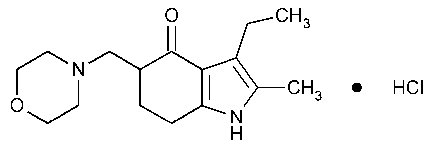Molindone Hydrochloride
4H-Indol-4-one,3-ethyl-1,5,6,7-tetrahydro-2-methyl-5-(4-morpholinylmethyl)-,monohydrochloride.
3-Ethyl-6,7-dihydro-2-methyl-5-(morpholinomethyl)indol-4(5H)-one monohydrochloride [15622-65-8].
»Molindone Hydrochloride contains not less than 98.0percent and not more than 101.5percent of C16H24N2O2·HCl,calculated on the anhydrous basis.
Packaging and storage—
Preserve in tight,light-resistant containers.
Identification—
A:
Infrared Absorption á197Kñ.Do not dry specimens.
B:
Prepare a solution in methanol containing 10mg of molindone hydrochloride per mL.Separately apply 1µLof this solution and 1µLof a Standard solution containing 10mg per mLof USP Molindone Hydrochloride RSin methanol to a thin-layer chromatographic plate (see Chromatography á621ñ)coated with a 0.25-mm layer of chromatographic silica gel mixture,and allow the spots to dry.Protect the chromatogram from light,and develop in a solvent system consisting of a mixture of alcohol,methanol,and 1Nhydrochloric acid (90:5:5)until the solvent front has moved about three-fourths of the length of the plate.Remove the plate from the developing chamber,mark the solvent front,and allow the solvent to evaporate.Spray the plate with a freshly prepared solution containing 100mg of potassium ferricyanide dissolved in 20mLof 10%ferric chloride solution:the principal spot obtained from the test solution corresponds in RFvalue and intensity to that obtained from the Standard solution.
C:
It responds to the tests for Chloride á191ñ.
pHá791ñ:
between 4.0and 5.0,in a solution (1in 100).
Water,Method Iá921ñ:
not more than 0.5%.
Residue on ignition á281ñ:
not more than 0.25%.
Heavy metals,Method IIá231ñ:
not more than 0.003%.
Chromatographic purity—
Mobile phase—
Dissolve 1.1g of sodium octanesulfonate in 600mLof water,add 400mLof methanol,1mLof glacial acetic acid,and 0.5mLof triethylamine.Mix,filter through a filter having a porosity of 0.45µm or less,and degas.Make adjustments if necessary (seeSystem Suitabilityunder Chromatography á621ñ).
Solvent mixture—
Proceed as directed in the Assay.
Standard solution—
Prepare a solution of USP Molindone Hydrochloride RSin Solvent mixturehaving a known concentration of about 0.01mg per mL.
Test solution—
Transfer about 100mg of Molindone Hydrochloride,accurately weighed,to a 50-mLvolumetric flask,dissolve in and dilute with Solvent mixtureto volume.
Chromatographic system
(see Chromatography á621ñ)—The liquid chromatograph is equipped with a 254-nm detector and a 4.6-mm ×25-cm column that contains packing L11.The column temperature is maintained at 35 .The flow rate is about 1.5mLper minute.Chromatograph the Standard solution,and record the peak responses as directed under Procedure:the relative standard deviation for replicate injections is not more than 5.0%.
.The flow rate is about 1.5mLper minute.Chromatograph the Standard solution,and record the peak responses as directed under Procedure:the relative standard deviation for replicate injections is not more than 5.0%.
Procedure—
Separately inject equal volumes (about 20µL)of the Standard solutionand the Test solutioninto the chromatograph,record the chromatograms,and measure the responses of all peaks:no peak from the Test solution,other than the molindone peak,is greater than the molindone peak from the Standard preparation(0.5%),and the sum of all the impurity peaks is not greater than 2.0%.
Assay—
Mobile phase—
Dissolve 1.1g of sodium octanesulfonate in 480mLof water,add 520mLof methanol,2mLof glacial acetic acid,and 0.4mLof triethylamine.Mix,filter through a 0.45-µm filter,and degas.Make adjustments if necessary (see System Suitabilityunder Chromatography á621ñ).
Solvent mixture—
Prepare a mixture of 0.01Nhydrochloric acid and methanol (60:40).
Internal standard solution—
Dissolve 200mg of butylparaben in 40mLof methanol in a 100-mLvolumetric flask,dilute with water to volume,and mix.
Standard preparation—
Transfer about 25mg of USP Molindone Hydrochloride RS,accurately weighed,to a 50-mLvolumetric flask,add 5.0mLof Internal standard solution,dilute with Solvent mixtureto volume,and mix.
Assay preparation—
Transfer about 50mg of Molindone Hydrochloride,accurately weighed,to a 100-mLvolumetric flask.Add 10.0mLof Internal standard solution,dilute with Solvent mixtureto volume,and mix.
Chromatographic system
(see Chromatography á621ñ)—The liquid chromatograph is equipped with a 254-nm detector and a 4.6-mm ×25-cm column that contains packing L11.The column temperature is maintained at 35 .The flow rate is 1.5mLper minute.Chromatograph the Standard preparation,and record the peak responses as directed under Procedure:the resolution,R,between the molindone and butylparaben peaks is not less than 2,and the relative standard deviation for replicate injections is not more than 2.0%.
.The flow rate is 1.5mLper minute.Chromatograph the Standard preparation,and record the peak responses as directed under Procedure:the resolution,R,between the molindone and butylparaben peaks is not less than 2,and the relative standard deviation for replicate injections is not more than 2.0%.
Procedure—
Separately inject equal volumes (about 10µL)of the Standard preparationand the Assay preparationinto the chromatograph,record the chromatograms,and measure the responses for the major peaks.The relative retention times are about 0.7for molindone and 1.0for butylparaben.Calculate the quantity,in mg,of C16H24N2O2·HCl in the portion of Molindone Hydrochloride taken by the formula:
100C(RU/RS),
in which Cis the concentration,in mg per mL,of USP Molindone Hydrochloride RSin the Standard preparation,and RUand RSare the ratios of the peak response of molindone to that of butylparaben obtained from the Assay preparationand the Standard preparation,respectively.
Auxiliary Information—
Staff Liaison:Ravi Ravichandran,Ph.D.,Senior Scientist
Expert Committee:(PA3)Pharmaceutical Analysis 3
USP28–NF23Page 1305
Phone Number:1-301-816-8330
